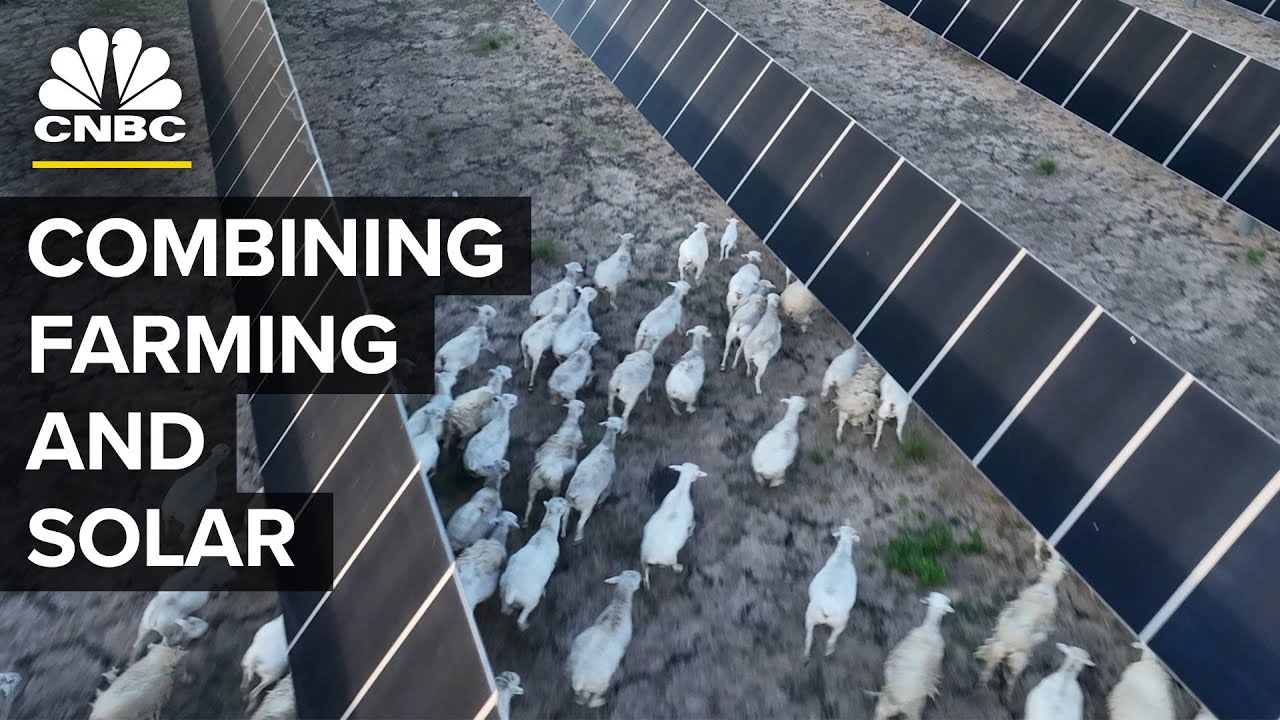Sheep, sheep, sheep,
sheep. This is what Amanda
Stoffels' life as a farmer In 2023 looks like. Raising and grazing sheep
among a vast field of Solar panels. It's a new, modern
approach to agriculture. Her growing flock helps to
maintain vegetation at Elm Branch Solar Farm, about
an hour south of Dallas, Texas. The farm is
operated by Lightsource BP, a solar energy
developer that's 50% owned By British oil major BP. Lightsource is investing
in solar developments like This, which combine
energy production with Agricultural activities
like sheep grazing, Beekeeping and hopefully
someday, crop growing. These are 6.5oz jars, but
they hold 8 ounces of Honey. And so it says on
our solar farm, honey, we Just packaged this up
just a couple of days ago. This is all part of an
emerging industry called Agrivoltaics, that oil
giants like BP and Shell Are getting into, as they
seek to burnish their Green energy portfolios
and enter into new Markets. There are state policies
and goals that are driving A lot of development of
utility scale solar Projects all across the
nation. These solar projects need
to find somewhere to build These projects, and in
many ways, they are Finding very willing and
eager owners With many agricultural
land owners and farmers. Landowners like Stoffels
and Koranek can earn a Guaranteed monthly income
by leasing their farmland To solar developers like
Lightsource. In this case, Lightsource
also pays Stoffels for
Sheep grazing, as her
herd keeps the plants Around the panels in
check and pays Koranek for The honey that he
produces at a nearby farm. But actually growing
crops on solar farms is Still a nascent industry,
leading to some land use Concerns. Solar takes some of the
best land out of Production because they
want land that's 1 to 4% Slope, and that's some of
the best land there is. Still, Agrivoltaic
projects are as close to a Win win for farmers and
solar developers as we Have right now. And as
the solar industry rapidly Expands, experts say that
this type of multi-use Land management will
become more and more Common. Meeting the nation's
decarbonization goals is Going to involve building
out a massive amount of Utility scale solar. To decarbonize our energy
grid, we need about 1000GW Of solar deployment, up
from about 150GW today. That doesn't require a
ton of land, about 6 Million acres of land,
or, you know, only about a Third of a percent of all
the land in the contiguous United States. Agricultural land
comprises a whopping 44% Of the United States
total land area, and often Has ideal characteristics
for solar energy Production. We are often looking for
areas that are flat, areas That do not have
extensive trees and Vegetation, and that are
located close to two Transmission and power
lines. But developers interest in
farmland can cause tension With farmers.
That even though the
United States is a very Large country with a lot
of available land, every Single square inch of
land is either owned, Protected, or cherished
by someone or many people. And many people do not
want to see that land Change or transform into
something different from What it has been, and for
good reason. Agrivoltaic projects could
be a sort of compromise. So Agrivoltaics really
offers us that opportunity To continue farming,
continue doing these Agricultural activities,
while also producing clean Electricity. Today, the U.S. Has about 5 gigawatts of
agrivoltaic projects Encompassing 35,000 acres
across over 30 different States. This only
represents about 3% of the Country's entire
installed solar capacity, But it's growing. For solar developers, I
think the attraction of Agrivoltaics is largely
that It helps with community
acceptance and community Excitement about solar
projects. Grazing land in This country is about a
third of all of our land Use, and if you're able
to make that a dual use With solar energy
production, you have now Opened up a huge
potential market space That wasn't open before. Lightsource BP operates a
combined 615MW of sheep Grazing and solar power
projects. 12% of the nation's
entire Agrivoltaic Portfolio, and the
company plans to add an Additional 1058MW worth
of projects next year. Through its 44% stake in
solar developer Silicon Ranch, Shell is also
involved in the space.
Silicon Ranch operates
1300MW of agrivoltaic Projects, a full 26% of
the nation's total, with An additional 900MW
planned over the next 2 Years. American oil
majors like Chevron and Exxon haven't invested in
Agrivoltaics, and while There are other players
in the domestic market, They're generally much
smaller scale than Lightsource and Silicon
Ranch. Amanda Stoffels and her
husband bought 100 acres Of farmland after they
got married in 2005. On top of their 9 to 5
jobs, they raised cattle On their land for 15
years. But when the opportunity
arose to lease land to Lightsource BP, the
steady monthly payments Allowed Stoffels to quit
her other job and farm Full-time. Now, the
majority of her land is Devoted to solar, and
she's acquired a growing Flock of 350 sheep. Lightsource pays her to
graze her sheep on the Solar farm, so that the
surrounding vegetation Doesn't grow so high that
it blocks the panels. When people ask me, well,
why do you do it? It allows me to diversify
our income and still be in The agricultural
business, and to be able To utilize modern life
and hold on To an ancient practice of
shepherding sheep. There are a total of 10
families, including the Stoffels, that partner
with Lightsource to graze Sheep amongst the panels,
and 2 families that have Beekeeping operations on
site. Lexie Hain, director of
Agrivoltaics and land Management at
Lightsource, says that the More direct benefits
families like these see, The easier it is to get
solar projects approved
And what can be a
notoriously difficult Permitting environment. It's the farmer partners
that. Are the most important,
those community members Who they might be your
land owners, they might be The neighbors. They might
be the sheep farmer who Want that grazing
opportunity. But that's the real thing
that helps a project Through the through
permitting. Tom Koranek is a landowner
with a background in the Crop protection industry,
which focuses on products Like herbicides and
insecticides. He used to Grow crops on the 168
acres of land that he now Leases to Lightsource. The solar farm has been a
farm for a long time, over 100 years, and we
purchased it about 12 Years ago. And since then
we've grown, rotated their Cotton, corn, sorghum,
sunflowers and wheat. And then in about 19, we
leased it to the solar Farm. Koranek couldn't disclose
the specifics of his Contract with
Lightsource, but said that The money from the lease
has allowed him to make Improvements on the
remaining 172 acres that He still operates. So leasing it for solar,
how much do you make per Year? We sign an agreement not
to discuss it. It's more. It's more than
row crop, I'll tell you That. As a part of his contract. He also has a commitment
to sell 1500 jars of honey To Lightsource over a 3
year period, which the Company then gives away
as promotional gifts.
We've increased our number
of hives, and we will Continue to increase it
to meet our commitment to The solar company. The Shell backed solar
developer Silicon Ranch Has a different model. While most solar
developers lease their Land, Silicon Ranch buys
it outright, often Purchasing degraded
farmland that's no longer In production. The
company focuses on Regenerative land
management, aiming to Improve soil quality by
eliminating the use of Pesticides and herbicides
and implementing more Intentional grazing
methods, among other Things. We from the beginning
said, we want to tell These communities that we
are committed for the long Haul, and we're going to
become members of these Communities in meaningful
ways. So our business model of
owning real estate was a Function of how we viewed
this asset class. The company operates
primarily in the southeast In states like Tennessee,
Georgia and Mississippi, Mostly buying land from
large corporate Landholders like
Lightsource. Silicon Ranch pays local
ranchers to graze sheep on Their solar farms. But Farr says that
they've actually run up Against a sheep shortage,
leading the company to Invest in its own flock. We started with a flock of
about 600. Today we've grown that
flock to 2000, and if all Of our projections pan
out, we think we'll have a Flock of over 30,000
sheep by 2030. But among farmers, solar
development is still often
Viewed with a certain
degree of skepticism, even If agrivoltaic elements
like sheep grazing and Pollinator habitats are
involved. It's kind of a touchy
subject with a lot of Farmers because they want
to maintain their property And crop production, and
they understand the need To transition to maybe
some more different kinds Of energy production. But at the same time,
their land has been in Production for over 100
years in their family, and They and they're really
tied to the land. Though many crops like
tomatoes and broccoli can Theoretically grow
beneath solar panels, the Design of the solar array
usually needs to be Altered, often by further
elevating the panels to Allow taller crops to
grow. But this is costly. And while the economics
can work for small-scale Projects in markets with
strong solar incentives, Scaling up is a
challenge. But as we go beyond some
of these specialty markets And get into utility
scale solar projects, the Design accommodations one
might make to grow crops Underneath and in between
solar panels are going to Be more expensive and
have a bigger impact on The overall economic
viability of that that Solar project. Macknick says that given
existing costs and energy Markets, he doesn't see
crop production happening At a scale larger than
five megawatts, which is About 30 times smaller
than the Lightsource farms Where Stoffels and
Koranek work. And when it comes to
grazing, animals, besides, Sheep pose distinct
challenges. Goats are Prone to chewing on the
panels wires, while cows
And horses are so large
that they can damage the Panels and are physically
unable to graze beneath Them. But if you're a
landowner, Koranek says That you can definitely
stand to benefit from Leasing. It's a much better
financial contribution Than growing crops. Crops are very risky, so
some years you may make a Good return and other
years you may not. And so this is a steady
income year every year. Farr says that for many
families, selling the land Outright can be an even
more attractive option Than a long-term lease,
especially if that land is No longer in production. What we see a lot of is
there has been a farm in The family and the
parents have either passed Or are done farming, and
it's now in multiple Children's hands, and
none of them agree on what To do. Being able to sell
the farm for a meaningful Amount of liquid capital
on day one is a very Helpful for for families
that can agree on how best To monetize the asset
they've inherited from Their parents. But whether developers are
leasing or buying, Everyone agrees that
making the value Proposition clear to
farmers is integral to Opening up new markets. We are coming in to help
support farmers, to Provide farmers another
income stream, in finding Another way to make, you
know, our agricultural System more economically
resilient. So, I think Agrivoltaics
has the opportunity to Allow solar projects to
be built in these rural Areas that that
traditionally have opposed
Solar development. As the U.S. pursues a
massive buildout of Utility-scale solar, many
are hoping to see more State and federal
incentives for agrivoltaic Projects. So we've already seen some
states take an interest in Agrivoltaics and offer
some types of incentives To support its
development. We've seen, For example, the SMART
program in Massachusetts. New Jersey has a has a
program. Other states like Oregon,
California, other states Have been talking about
legislation. Right now, the Department
of Energy is funding 6 Agrivoltaic projects with
the goal of enabling the Deployment of over 1MW of
projects focused on crop Production and over 10MW
of projects focused on Grazing and pollinator
habitats. So the five gigawatts of
systems that have been Installed today represent
more than $5 billion of Investments, somewhere
between $5 and $10 billion Of investment. And we really see the
potential for this market Kind of to have no bound. Lightsource BP says that
it's interested in getting Into crop production,
hoping that one of its Sites can serve as a test
project next year. While Fara says that
Silicon Ranch isn't Pursuing partnerships in
this space yet, but Whatever route both
companies and their Backers in the oil
industry take when it Comes to agrivoltaic
development, community Relationships and
mutually beneficial land Use arrangements are
going to be paramount to Building enough solar for
the energy transition.
I think we need to do more
than just provide Renewable electrons. We need to have positive
impacts on the ecosystems Where we operate. We need
to bring value to the Communities where we site
these solar arrays, or We're going to lose our
social license to operate. And that's going to hurt
our ability to meet some Of these very aggressive,
renewable energy goals That we have as a
country.





